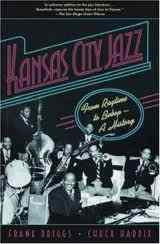Kansas City Jazz:
A Pictorial Tour
_____
In cooperation with Frank Driggs and Chuck Haddix, authors of Kansas City Jazz: From Ragtime to Bebop — a look at the fascinating history of Kansas City’s golden age through book excerpts, photos and music
*
All photos and book excerpts used with the permission of Frank Driggs, author of Kansas City Jazz: From Ragtime to Bebop — A History

_______________________________________________________________
“Don’t hang your head when you see those six pretty horses pullin’ me.
Put a twenty-dollar silver piece on my watch chain,
Look at the smile on my face,
And sing a little song to let the world know I’m really free.
Don’t cry for me, ’cause I’m going to Kansas City.”
– Music by Charlie Parker and lyrics by King Pleasure, Parker’s Mood ,” 1953
photo Driggs Collection
Downtown Kansas City in the 1920s
____
“If you want to see some sin, forget Paris and go to Kansas City. With the possible exception of such renowned centers as Singapore and Port Said, Kansas City has the greatest sin industry in the world.”
– Edward Murrow of the Omaha World-Hearld
*
Kansas City Shuffle , by Bennie Moten
__________
photo Driggs Collection
Tom Pendergast and wife, 1936
_____
“Kansas City’s government, ruled from 1911 to 1939 by a Democratic political machine driven by Tom Pendergast, a burly Irishman with a twinkle in his eye, fostered the wanton nightlife rife with gambling, prostitution, and bootlegging.
“Tom Pendergast was the man who made Kansas City the draw for entertainment and nightlife until tax evasion brought him down in 1939.”
– Chuck Haddix and Frank Driggs
courtesy Duncan Schiedt
Coon-Sanders Novelty Orchestra, Kansas City, 1920
Left to right: Carleton Coon, drums/vocals/co-founder; Carl Nocatero, trombone; Hal McClain, alto sax; Harry Silverstone, violin; Joe Sanders, piano/vocals/co-founder; Harold Thiell, C melody sax; Bob Norfleet, banjo; Clyde Hendrick, trumpet.
_____
“Debuting in 1920, Coon-Sanders relied mainly on novelty work. Their long run at the Muehlebach Hotel coupled with regular broadcasts overWDAF eventually brought them to Chicago’s Congress Hotel in 1924.”
– Chuck Haddix and Frank Driggs
*
Yes Sir, That’s My Baby , by the Coon-Sanders Nighthawks
__________
photo Driggs Collection
Loren McMurray, the first star of Kansas City whose fame extended elsewhere, 1922
_____
“McMurray, stout with a lantern jaw and slicked-back brown hair parted down the middle in the style of the day, readily established a reputation as an innovator and outstanding soloist. Clarinetist Cy Dewar rememberd McMurray as ‘one of the finest hot men’ in Kansas City and the ‘first to play the A-flat also, while everyone was playing the C melody, also the first to start the slap tongue vogue’…A severe case of tonsillitis nipped McMurray’s brilliant career in the bud…[He] died on October 29, 1922, at the age of twenty-five. News of his death sent shock waves through the music community of Kansas City.”
– Chuck Haddix and Frank Driggs




























